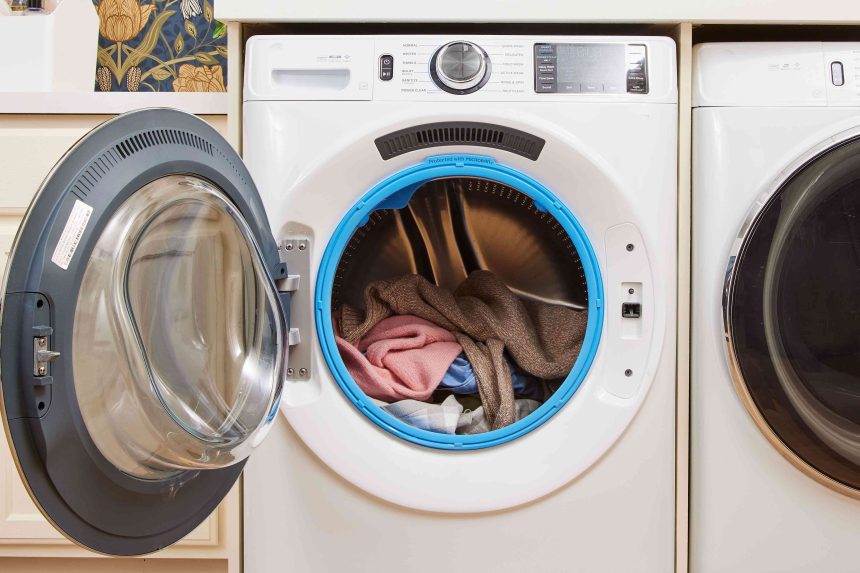When it comes to buying a new home, packing might be the biggest headache. As you think about boxing your decor and clothing for the next place, you might wonder about moving your kitchen appliances. Typically, features such as light fixtures must remain behind in a home unless otherwise negotiated. Does the same go for your fridge and dishwasher? Explore the answers as experts weigh in on whether you should take your appliances when you move.
Can You Take Your Appliances?
“A seller is not obligated to include appliances in the sale of their home, though it is often expected, especially in markets like NYC,” says agent Maria Kourepenos of Coldwell Banker Warburg. “If a seller prefers not to include them, it’s important they discuss this with their real estate agent, who can provide guidance based on buyer expectations in their particular market.”
Maybe you’ve become attached to your gas stove, or the fridge you bought happens to match the microwave and dishwasher you recently invested in. Whatever the case, you might wish you could take your appliances with you to your new home.
The good news is you can absolutely do that. You’ll just need to check all the boxes.
“First things first, I always recommend consulting with your realtor about local norms. They are the experts regarding buyer expectations, and whether or not to leave your appliances falls into that category,” says Margaret Osborne, realtor at Better Homes and Gardens Real Estate Central.
Osborne says these trends have shifted over the years. “In my direct market, it’s been common for sellers to leave all kitchen appliances but take their washer and dryer. However, over the past five years, more sellers are opting to leave their washers and dryers, and it is not uncommon for buyers to request their inclusion as well,” she says.
In other parts of the country, appliances are not considered part of the home, and many people take them. “Appliances are personal property and are not part of the home in a real estate transaction,” says Daniel Hussey, a broker with Hillside Realty in Wells, Maine. “A buyer must specify which appliances they would like in a purchase and sales agreement.”
Negotiating Appliances in a House Sale
Like all conditions of a home sale, the inclusion or removal of appliances in your home needs to be spelled out in writing and agreed upon by both parties.
“In most cases, built-in appliances such as dishwashers and ovens are considered fixtures and remain with the home, while freestanding appliances—like washers and dryers, an extra fridge, or a humidifier—can be negotiated,” says Cindy Raney, a global luxury property specialist and founder of Cindy Raney & Team. “It’s important to always verify which appliances are staying on the MLS sheet.”
As you draw up your contracts, be specific about what you want to leave and take. That’s good advice regardless of what you’re negotiating, whether it’s appliances, light fixtures, cleaning fees, or junk removal.
“Buyers and sellers should clearly outline in the contract which appliances will be included or excluded,” Raney says. “Sellers can specify which items they plan to take on a list of exclusions, and buyers can request certain appliances be left behind as part of their offer. Open communication and listing these details in writing help prevent misunderstandings later in the process.”
“Clearly negotiate whether or not to include or exclude something at the offer stage between agents, and ensure that everything that the buyer and seller have agreed upon is explicitly written as either an inclusion or exclusion in the deal sheet and the contract,” says agent Alana Lindsay of Coldwell Banker Warburg.
The Pros and Cons of Taking Appliances
Before you schedule movers to move your appliances to your next home, consider the pros and cons of this decision.
Pros
The main pro is that you get to keep your preferred appliances, which are presumably in decent shape and to your liking. This is especially helpful if the home you’re moving into doesn’t have any appliances. Keeping your current washer and dryer then saves you hundreds, if not thousands, of dollars.
“Homeowners can evaluate the cost of replacing an appliance versus moving with the current appliance by checking what the appliance costs now,” Lindsay says. “For example, if a homeowner purchased a washer and dryer set for $5,000 two years ago, and it would cost another $3,000 to move that set to another location, then it may not be worth it if they can get a new set in their new location for $6,000.”
Cons
If you’re moving into a home that already has appliances, you’ll need to remove them and properly dispose of them before installing yours. This can be a hassle.
“In most cases, the cons of keeping appliances outweigh the pros. “While some may consider selling them independently, the time, effort, and hassle often don’t justify the potential profit.”
— MARIA KOUREPENOS
Additionally, moving these bulky items is not free. In many cases, you’ll need to hire professionals to disconnect, pack, and relocate these heavy pieces.
“Moving companies often charge based on the truck size or total weight, which can increase your expenses due to those bulky and heavy appliances,” Osborne says. “It’s a good idea to consider purchasing extra insurance to cover any potential damage during the move. While we often envision a ‘best-case scenario,’ don’t forget to factor in storage costs if you can’t transition directly between homes.”
Keep in mind that washing machines, dryers, and dishwashers all require special plumbing and venting. Refrigerators and other large appliances also require the proper electrical hookup. In short, you shouldn’t install these items without proper knowledge.
Finally, choosing to take your appliances with you could be a drawback for your home’s buyer. If keeping your appliances jeopardizes the sale of your home in any way, you may want to reconsider your decision in favor of the bigger picture. This is especially true if your home is damaged in the process of having these bulky items moved.
“Large appliances can be difficult to move and can easily damage floors and walls,” Hussey says. “Any damage to the home before the closing is the seller’s responsibility. If damage does occur during the move, before the closing, it could be the seller’s responsibility to repair or mitigate any damage done.”
Exceptions
Still, feel like you want to keep your microwave? There are of course exceptions that will far outweigh the challenges you might face moving that appliance.
“The exception might be if there is sentimental value attached to an appliance, such as an antique oven or a family heirloom refrigerator,” says Kourepenos. “In those cases, sellers can either move the appliance elsewhere or offer buyers a credit toward a replacement while making it clear that the item is not included in the sale.”
How to Decide
As you decide whether to take your current appliances with you, consider the following four factors:
1. Price
You could save money by moving your current appliances, but keep in mind that, while you might not have to buy new appliances, you will have to pay someone to move and hook up your current ones.
“The cost of moving appliances includes not only transportation but also potential fees for disconnecting, reconnecting, and possibly adapting appliances to fit the new home,” Raney says. “These costs can add up quickly and may not be worth the expense, especially if the appliances are older or not compatible with the new home’s setup.”
Raney had a client who took their washer and dryer and spent a lot of money to move it. Once in the new home, the movers went to install the new washing machine and did not know how to shut the water off, causing a leak.
“Movers will try to be helpful, but most are not trained in appliance installation,” Raney cautions.
2. Condition
Consider how long your current appliances will last and compare them to the ones you might inherit with a new home purchase or buy if you go with a new one.
“Homeowners should weigh the age, value, and condition of their appliances against the cost and effort of moving them,” Raney says. “If appliances are nearing the end of their life span, it may be more cost-effective to sell or leave them behind and invest in new ones that better suit the new home.”
3. Negotiating Power
Many home buyers like to see that their new home comes with good, working appliances. If you remove yours, you could lower the quality of the deal potential buyers are expecting.
“We recommend selling listings turnkey with all appliances included. Sometimes a seller is very attached to an item such as their washer and dryer and requests to take them,” Raney says. “That should not turn off a buyer in the end or affect the overall desirability of the home. However, if a seller excludes expensive luxury items like a beautiful freestanding wine fridge that fits perfectly in a built in bar, making it turnkey and desirable, that may give a buyer pause.”
4. Moving the Appliances
Whether you do it yourself or hire a crew, moving appliances is added work that can cost money and time. You’ll also want to make sure your current appliances will fit in their new space.
“Moving large appliances can be challenging due to their size, weight, and the need for professional disconnection and reconnection,” Raney says. “It’s important to ensure that the new home can accommodate the appliances in terms of space, utility hookups, and compatibility. Homeowners may also face the risk of damaging appliances during transport, adding to the logistical hurdles.”




